
The transport system in Malta is small but extensive, and the islands' domestic system of public transport is reliant on buses and taxis, although there were both a railway and a tramway in the past.

Victoria, also known among the native Maltese as Rabat or by its title Città Victoria, is an administrative unit of Malta, and the main town on Gozo. Victoria has a total population of 6,901, and is the most populous settlement in Gozo.
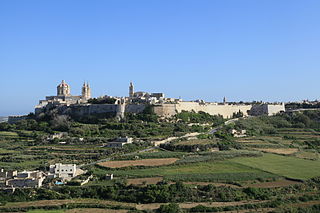
Mdina, also known by its Italian epithets Città Vecchia and Città Notabile, is a fortified city in the Northern Region of Malta which served as the island's former capital, from antiquity to the medieval period. The city is still confined within its walls, and has a population of 250, but it is contiguous with the town of Rabat, which takes its name from the Arabic word for suburb, and has a population of over 11,000.
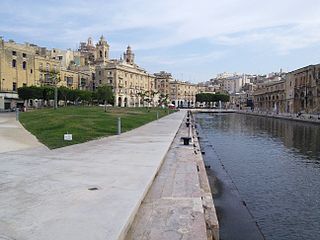
Cospicua (Italian) or Bormla, occasionally also known by the Latin name Cottonera, is a double-fortified harbour city in the Port Region of Malta. As Maleth, it served as the principal port of Phoenician Malta and, through Greek, Latin, and Arabic, may have given its name to the island and country. Along with Birgu and Senglea, it is one of the Three Cities located within the Grand Harbour to the east of the capital city Valletta. With a population of 5,395 as of March 2014, it is the most dense city of the Three Cities. Locals are known for their Cottonera dialect.
Carmelo "Carm" Mifsud Bonnici is a Maltese politician who has served in a number of Ministerial posts in the Government of Malta.

St Aloysius College (SAC) is a Catholic primary, secondary and post-secondary education institution run by the Euro-Mediterranean Province of the Society of Jesus in Birkirkara, Malta. It was founded by the Jesuits in 1907 to complement the seminaries and tertiary institutions already in existence on the island. Today, it comprises a coeducational primary school, boys' secondary school, and a coeducational sixth form. The college compound also houses its own church which is used by the college community and open to the public, as well as a Sports and Recreational Complex.

Maltese architecture has its origins in prehistory, and some of the oldest free-standing structures on Earth – a series of megalithic temples – can be found on Malta. The islands were colonized by the Phoenicians and later the Romans, who established the cities of Melite and Gaulos. Although these were substantial settlements and are known to have had numerous temples, churches and palaces, few remains have survived apart from some architectural fragments.

Heritage Malta is the Maltese national agency for museums, conservation practice and cultural heritage. Created by the Cultural Heritage Act, enacted in 2002, the national agency replaced the former Museums Department.
The Maltese order of precedence is a conventionally set list. It is only used as a guide for protocol.
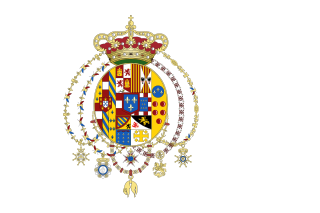
The Gozitan Nation, commonly known as Gozo, was an unrecognised state located on the island of Gozo between 1798 and 1801 during the French Revolutionary Wars. It was a monarchy recognizing the authority of Ferdinand III of Sicily with a provisional government led by Governor-General Saverio Cassar. Its capital was Rabat. The country was established between 28 and 29 October 1798 from the territory of French-occupied Malta and was eventually incorporated into Malta Protectorate on 20 August 1801.

The fortifications of Malta consist of a number of walled cities, citadels, forts, towers, batteries, redoubts, entrenchments and pillboxes. The fortifications were built over hundreds of years, from around 1450 BC to the mid-20th century, and they are a result of the Maltese islands' strategic position and natural harbours, which have made them very desirable for various powers.

The fortifications of Mdina are a series of defensive walls which surround Mdina, the former capital city of Malta from antiquity to the medieval period. The city was founded as Maleth by the Phoenicians in around the 8th century BC, and it later became part of the Roman Empire under the name Melite. The ancient city was surrounded by walls, but very few remains of these have survived.

Melite or Melita (Latin) was an ancient city located on the site of present-day Mdina and Rabat, Malta. It started out as a Bronze Age settlement, which developed into a city called Ann under the Phoenicians and became the administrative centre of the island. The city fell to the Roman Republic in 218 BC, and it remained part of the Roman and later the Byzantine Empire until 870 AD, when it was captured and destroyed by the Aghlabids. The city was then rebuilt and renamed Medina, giving rise to the present name Mdina. It remained Malta's capital city until 1530.
Seismic risk in Malta is considered to be low with little historic damage noted and no known victims. The archipelago is however in a potentially significant seismic zone and the risk to the population is probably undervalued.

The 1813–1814 Malta plague epidemic was the last major outbreak of plague on the islands of Malta and Gozo. It occurred between March 1813 and January 1814 on Malta and between February and May 1814 on Gozo, and the epidemic was officially declared to be over in September 1814. It resulted in approximately 4500 deaths, which was about 5% of the islands' population.
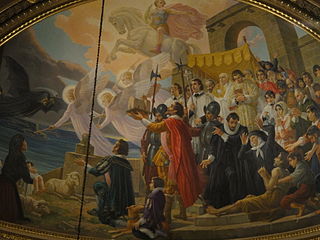
The 1675–1676 Malta plague epidemic was a major outbreak of plague on the island of Malta, then ruled by the Order of St John. It occurred between December 1675 and August 1676, and resulted in approximately 11,300 deaths, making it the deadliest epidemic in Maltese history. Most deaths were in the urban areas, including the capital Valletta and the Three Cities, which had a mortality rate of about 41%. In the rural settlements, the mortality rate was 6.9%.
The Notarial Archives is an archive in Valletta, Malta, that contains about 20,000 volumes of contracts, wills and other legal documents from the 15th century to the present day. Its collections are significant both from a legal and historical point of view, and they include Il-Kantilena, the earliest known text in the Maltese language. The Notarial Archives fall within the remit of the Office of the Notary to Government, within the Ministry for Justice, of Malta.

The Mdina Cathedral Museum is a religious art museum located inside the mediaeval walled city of Mdina, Malta. The museum is housed within a Baroque building that was built as a Jesuit seminary. It can be found on the right-hand side of the St. Paul's Cathedral, in Archbishop's Square. The museum's collection includes an eclectic secular and ecclesiastical repertoire. The museum also holds various artwork and archaeology remains, including important artwork by Mattia Preti. The museum also owns the most important collection of Italian Baroque music that has been preserved south of Naples.
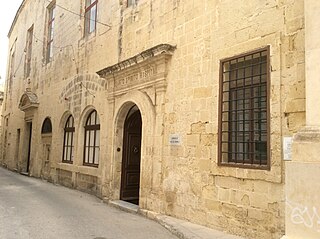
The Santo Spirito Hospital, originally known as the St. Francis Hospital, is a former hospital in Rabat, Malta which functioned from at least the 14th century to 1967. Since 1994, the hospital building has housed the head office of the National Archives of Malta.

















